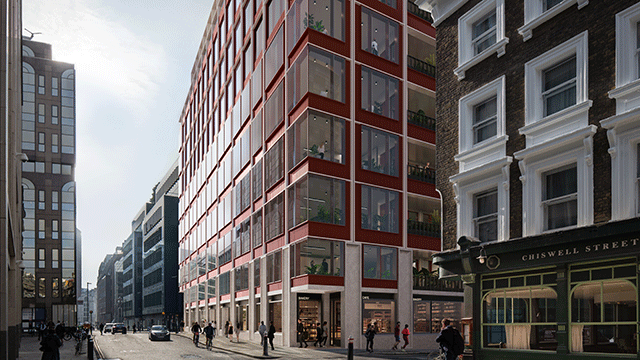In Associated
Deliveries Ltd v Harrison [1984] 2 EGLR 76, the Court of Appeal
considered whether a tenant whose lease had been forfeited by the service of a
writ claiming possession could be made liable under his repairing obligations
for damage occurring to the demised property between the date of service and
the date when he finally delivered up possession to the landlord. Although the
court decided that he could not remain liable under the repairing covenant once
the lease was forfeited, it did consider alternative ways in which he could be
made responsible for damage to the property during this twilight period.
The property
was a light industrial unit let in 1973 for a term of 14 years. The lease
contained full repairing and redecorating covenants on the tenant’s part, plus
an obligation to deliver up the premises to the landlord in repair at the
expiration or sooner determination of the term. There was also a proviso for
re-entry in case of breach of covenant. In October 1979 the landlord issued and
served a writ against the original tenant and his assignee claiming forfeiture
of the lease and damages on the ground that there were breaches of the
repairing covenants.
It is
settled law that where a writ claiming forfeiture and possession is issued and
served, the term created by the lease in question determines at the date of
service of the writ on the defendant. If the tenant does not leave the premises
and the landlord seeks an order for possession from the court, interesting
questions can arise concerning the status of the former tenant and his
responsibilities in the ‘twilight period’ between service of the writ and the
decision of the court. The court may make an order for possession, or it may
decide that there was no breach, or a technical fault may trip up the landlord;
equally, the court may grant relief from forfeiture, thus restoring the lease
on terms, or the parties may informally agree upon relief.
In the
present case a period of over a year elapsed between the date of service of the
writ and the date when the court made an order for possession (the tenant not
having relinquished possession in the meantime). At the date of service of the
writ there were serious breaches of the repairing obligations in the lease, but
by the time possession was actually given up the condition of the property had
severely deteriorated as a result of the depredations of vandals. The tenant
denied liability under his repairing obligations for any damage which had
occurred after the service of the writ.
The Court of
Appeal accepted the tenant’s argument and upheld the judgment of Younger J in Wheeler
v Keeble (1914) Ltd [1920] 1 Ch 57. If a lease is determined by the
service of a writ it must, they said, follow that the landlord’s election to
determine the lease in that way puts an end to the tenant’s continuing
liability on his covenants. It also follows that the tenant can be liable for
breaches occurring only up to the time of the service of the writ and not for
subsequent dilapidation.
The court
was slightly troubled by this conclusion and considered how its effects could
be mitigated. They thought that if a claim was appropriately pleaded the former
tenant could be made liable in tort for damage occurring to the property during
the ‘twilight period’. A claim for mesne profits could cover such damage, although
that did not assist in the present case, since the statement of claim limited
the mesne profits claim to the amount of rent passing under the former lease.
Dillon LJ thought that a mesne profits claim could go beyond damages for
unlawful occupation and could include more general damages suffered by the
landlord resulting from his inability to gain access to the property in order
to secure it. Such a claim would have to be properly pleaded and would, of
course, be subject to the normal tort rules relating to causation and
remoteness.
The case
casts light on what must be a recurrent problem in similar cases. Legal
advisers preparing a forfeiture case must bear in mind that, once proceedings
are served, they cannot rely on the tenant’s covenants to protect the property
until possession is actually recovered. This decision clearly indicates that it
would be wise to leave open the possibility of a claim in tort.
tree is it anyway?
Two
successive summers full of sunshine (just like they used to be when we were
young, perhaps?) and already the building trade is anxiously considering the
prospect of another deluge of subsidence-related complaints such as followed
the droughts of 1975 and, more especially, 1976. ‘Followed’, but at a very
respectful distance — the courts are still in the process of working through
the pile of writs served at that time by anguished householders who found their
homes slipping from under them. We shall no doubt have to wait until the late
1980s to see whether there is to be a repeat performance; in the meantime,
however, another of the last crop of cases makes interesting reading.
The case of Russell
and Another v Barnet LBC (1984) 271 EG 699, 779 concerned a
house in Hampstead Garden Suburb which was built in about 1935. In the street
outside (then a private road, but adopted by the local authority in 1948) stood
two large oak trees, planted in all probability about 1835, the roots of which
grew under the house. For some 40 years these trees did no apparent harm to the
property but, in the extreme drought conditions of 1976, the effect of their
water demands upon the London clay subsoil led to extensive subsidence of the
foundations and consequent structural damage. The plaintiffs, who had purchased
a 2000-year lease of the property in 1970 and who subsequently, in 1978,
acquired the freehold, sought damages from the defendant local authority on the
grounds of nuisance and negligence, to be met by the response that the trees
were actually owned by the plaintiffs themselves!
The
defendants’ argument on ownership was based on an ancient rule by which the
owner of property which adjoins a highway is presumed also to own the subsoil
as far as the middle of the road. Of course, this ‘ownership’ is seldom of
great practical value, at least in urban areas; the highway authority has
wide-ranging statutory rights and powers which extend downwards as far as they
need to go, and the adjoining owners’ rights are further eroded by the powers
of those public bodies responsible for telephones, electricity, gas and water.
None the less, Tudor Evans J insisted that the presumption as to ownership of
the subsoil remains, and that it carries with it a similar presumption in
relation to trees growing in the subsoil.
One up to
the defendants, then, but the plaintiffs fought hard to convince the learned
judge that the presumption was rebutted in this particular case. The Land
Registry plans showed nothing of this subterranean extension to the property,
but indicated the boundary line as being where the pavement began; further,
various clauses in the lease appeared to have been based on the premise that
this was so. However, these arguments proved unsuccessful, as did a spirited
attempt to show that the trees had vested in the local authority upon adoption
along with the rest of the street under section 149 of the Public Health Act
1875 (now replaced by section 96 of the Highways Act 1980). After detailed
consideration of the legislation history of this ‘unsatisfactory and difficult
branch of law’, the judge concluded that the trees were indeed the plaintiffs’
own property.
However,
that was very far from being the end of the matter. A second line of argument
put forward by the plaintiffs was that, irrespective of ownership of the
trees, the defendants were sufficiently in control of them to carry
responsibility for any nuisance. Once again, recourse was had to the relevant
statutory provisions (in this case, section 82 of the Highways Act 1959, as
amended in 1961), and the judge agreed that the highway authority’s rights and
duties did indeed apply to pre-adoption as well as post-adoption trees. As a
result, it was held that if a case of common law nuisance could be made out,
the defendants would be liable.
It was now
the turn of the defendants to argue, and they did at least persuade Tudor Evans
J that, notwithstanding the decision of the Court of Appeal in Davey v Harrow
Corporation [1958] 1 QB 60, liability for encroaching roots was not strict
but rather based upon what the defendant knew or ought to know (equivalent to
other ‘natural cause’ nuisances — Leakey v National Trust [1980]
QB 485). However, this minor victory proved a transient one, for the evidence
clearly established that the defendants were indeed aware of the problems which
might arise from these particular trees. And so, since they could easily and
cheaply have averted the danger by pruning, they were liable to the plaintiffs
for the plaintiffs’ own trees!






